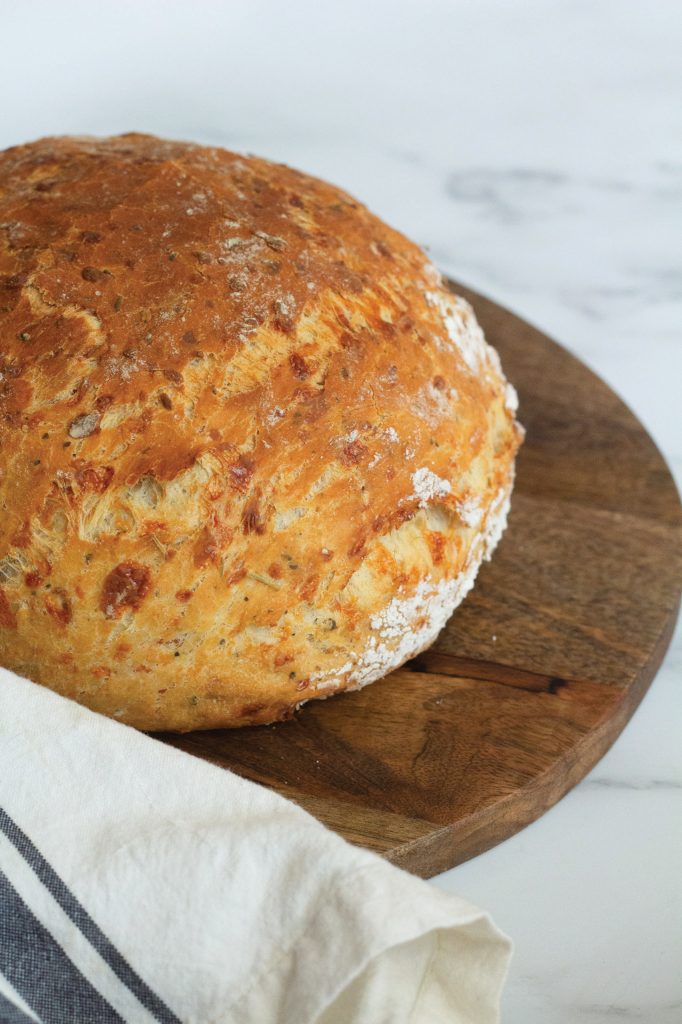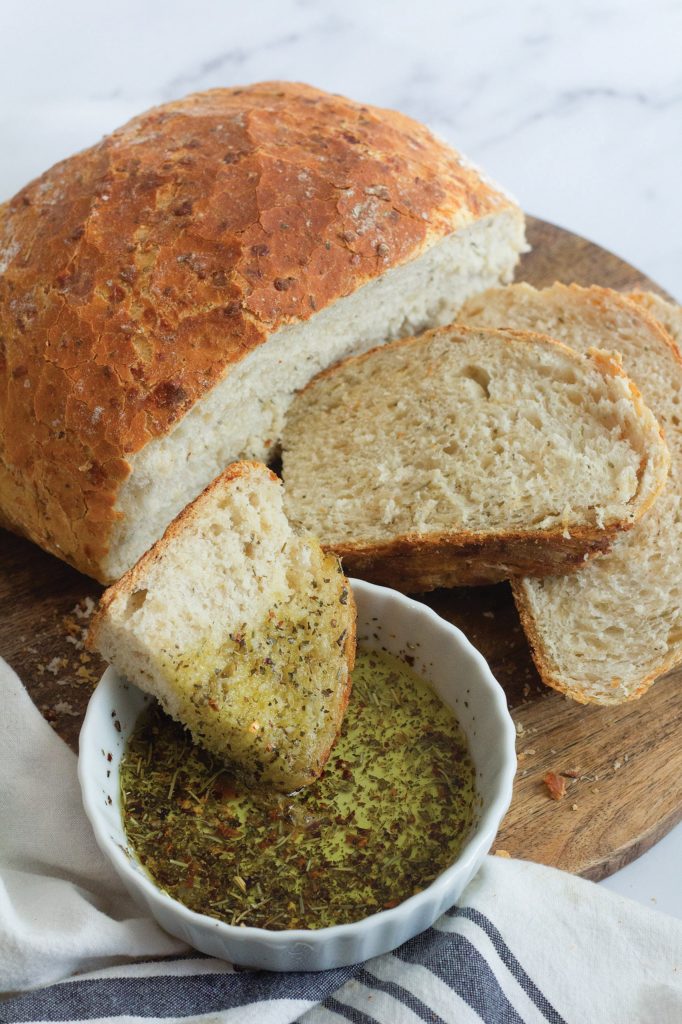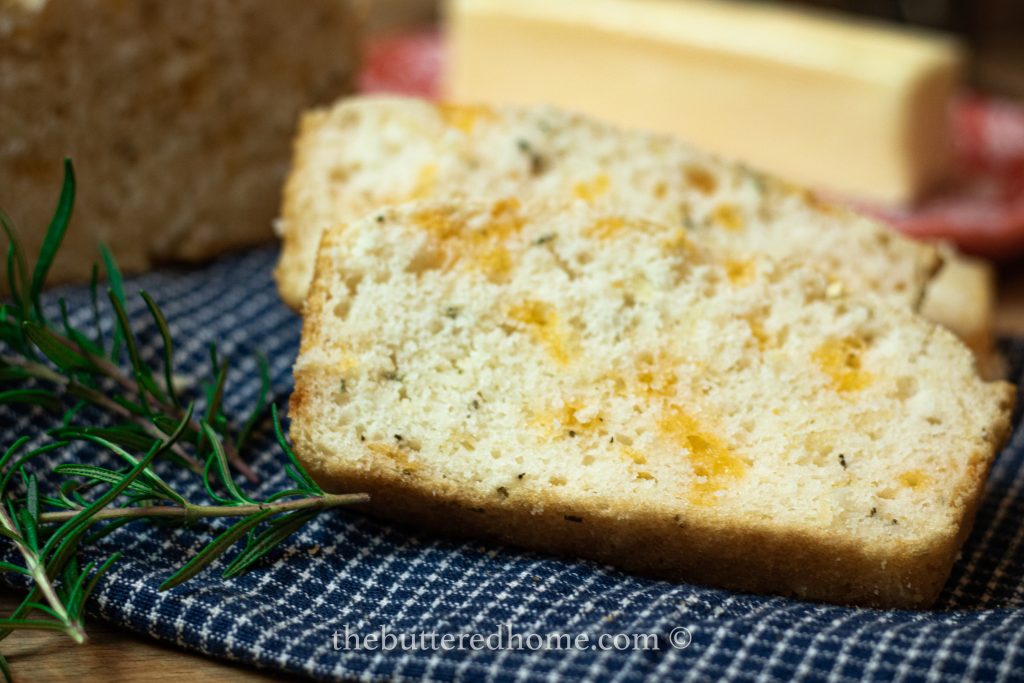Food styling and photos: Brooke Echols

Baking homemade bread became a regular pastime for many of us during the many months of COVID-related restrictions, and our readers were no exception. They sent us recipes not only for yeast-based breads but also sweet breads that are more like cakes, baked in a loaf pan. We’re printing a variety of bread recipes this month, with most calling for all-purpose flour or bread flour (which has a higher protein content and adds structure to your bread). Let us know how these recipes work for you at [email protected].

Cook of the Month
Victoria Rogers, Baldwin EMC
It took her two tries, but Victoria Rogers finally got her Parmesan Herb Artisan Bread to taste the way she wanted. She developed her recipe as part of a culinary class taught by Kristen Madsen at Gulf Shores High School. “We did a unit on yeast breads, and this was our last project of the section,” she says. “I developed the recipe by taking a traditional artisan bread recipe and adding flavors that I felt would complement the bread nicely: parmesan and rosemary. I also decided to add some basil and oregano to balance out the strong flavor of the rosemary.” The result was a delicious bread that was chosen as our spotlight recipe this month. Victoria says the bread is good on its own (and we would agree!), “but serving with a cheese or dipping oil elevates the flavor.” –Lenore Vickrey

Parmesan Herb Artisan Bread
2 teaspoons instant yeast
1 teaspoon sugar
1¼ cups warm water
3 cups all-purpose flour
1½ teaspoons salt
2½ cups parmesan cheese
2 teaspoons dried rosemary
1 teaspoon dried basil
1 teaspoon dried oregano
1 teaspoon garlic powder
Add the yeast, sugar and warm water to a bowl and wait until the yeast starts bubbling. Add the flour, salt, seasonings, parmesan and herbs. Mix together until fully combined. Oil the work surface and your hands and knead for 10 minutes. Once kneaded, place the dough in an oiled bowl. Cover and prove for 1 hour until doubled in size. Sprinkle the work surface with flour and tip the dough out onto the flour. Knead and shape dough. Continue until the dough no longer sticks in place. Turn the dough over and use your hands to finish off rounding it out. Place the dough in a well-floured bowl seam-side down. Cover and prove for 30 minutes. While proofing, place a dutch oven in the oven and preheat the oven to 450F. When the dough has finished its second proof, remove the cover. Very carefully take the hot Dutch oven out of the oven and remove the lid. Carefully lower the bread into the Dutch oven. Place the lid on top and place back into the oven. Bake for 30 minutes, then remove the lid and bake for another 10-15 minutes until golden brown. Remove from the oven and allow it to cool completely before serving.
Oatmeal Bread
1 cup oatmeal
2 cups water
3 tablespoons butter
1/2 cup brown sugar
1 teaspoon salt
2 tablespoons yeast
1 tablespoon sugar
1/3 cup warm water (110-115 degrees)
1/2 cup wheat flour
5 cups bread flour (and more as needed)
Cook oatmeal, water and butter on the stove top. Add brown sugar and salt. Cool. Dissolve yeast and sugar in warm water. Let mixture set for 5 minutes. Add cooled oatmeal mixture and yeast mixture to a mixing bowl. Add wheat flour and bread flour (1 cup at a time). Knead in mixer thoroughly. Add small amounts of bread flour if the dough is sticking to the side of the bowl. (Dough should be slightly sticky but not actually stick to your fingers.) Transfer dough to a greased bowl. Cover with a thin towel and let rise until double in size. Punch dough down and form into 2 loaves on a floured countertop. Place in greased bread pans. Cover again and let rise for 20-30 minutes. Bake at 350 for 25 minutes or until tops are golden brown and sides spring back when touched. Brush tops with butter. Remove loaves from pans and rest on cooling racks.
Cook’s notes: The dough should be slightly sticky but not stick a lot to the bowl or your fingers; add the full 5 cups of flour accordingly. Create a warm rising place for the bread by turning the oven on for 2 minutes and then turn it off. The temperature should be warm enough for the bread to rise without prematurely baking the dough.
Sheila Copenhaver, Covington EC
Dilly Casserole Bread
2½-3 cups flour, divided
2 teaspoons sugar
1 teaspoon onion powder
2 teaspoons dried dill weed (fresh dill can be substituted using 2
tablespoons)
1 teaspoon salt
½ teaspoon baking soda
1 egg
1 package active dry yeast
1 cup cottage cheese, creamed
¼ cup water
1 teaspoon butter, softened
Combine 1 cup flour, sugar, onion powder, dill weed, salt, baking soda and dry yeast. In a saucepan, heat cottage cheese, water and butter until mixture is warm. Add egg and warm liquid to the flour mixture. Blend at lowest speed with mixer until moistened; beat 3 minutes at medium speed. By hand, stir in remaining flour to form a stiff dough. Cover and let rise until doubled, about 1 hour. Punch down dough and place in a well-greased 8 or 9-inch round casserole or a 9×5-inch loaf pan. Let rise again for 30-40 minutes. Bake at 350 degrees for 35-40 minutes until golden brown. Brush with butter.
Nancy Sites Sizemore, Baldwin EMC

Hobo Bread
2½ cups leftover coffee or prepared instant coffee
4 teaspoons baking soda
2 cups raisins
1 cup granulated sugar
1 cup brown sugar
1½ cups pecans, chopped
4 cups flour, sifted
¼ teaspoon salt
Bring coffee to boil. Remove from heat, add baking soda and raisins. Cover and let stand overnight. In the morning, preheat oven to 325 degrees. Grease and flour 3 one-pound coffee tins. (Loaf pans may be substituted for coffee tins as pictured above.)To the coffee-raisin mixture, add nuts, flour, granulated sugar, brown sugar and salt. Mix well. Divide batter among the 3 cans; filling each slightly more than one half full. Bake at 325 degrees for 60 minutes. Let cool in can for 15 minutes before removing. If necessary, tap cans on bottom to release loaf. Turn loaves on side and slice into rounds for serving.
Dorothy Sapp, Arab EC
The Buttered Home

Homemade bread is a real delicacy. For many, including me, the art of making a beautiful sourdough or long-rise bread is a task that has proven hard to master. My daughter mastered sourdough starter during the quarantine of 2020. Me? I could never get it right. She even gave me detailed instructions and the starter to boot!
We can’t all do everything, so I resigned myself to just enjoy the glorious homemade bread that she made for me! I learned a long time ago that this wasn’t my strong suit. Give me biscuits or cornbread and I could make them perfect every time. So, if you are like me and enjoy the idea of a warm loaf of homemade bread, I am going to share my secret with you. This Rosemary Beer Bread has no rise time, no quick yeast and comes out just as good, in my opinion. Feel free to omit the cheese and rosemary for a plain bread. You can also substitute with other cheeses and spices to make any flavor of bread under the sun!
Rosemary Beer Bread
2 1/2 cups self-rising flour
3 tablespoons sugar
Pinch of salt
12 ounces beer, room temperature
1 tablespoon fresh rosemary, finely minced
1/2 cup Parmesan cheese, finely grated
1/2 cup cheddar cheese, grated
Preheat oven to 375 degrees. In a large bowl, add flour, sugar, salt, rosemary and cheeses. Use a whisk to sift together. Slowly pour in beer. Mix well just until combined. Do not over mix. Pour into a lightly greased loaf pan. Bake for 35-45 minutes. Cool in pan for 10 minutes and remove and allow to continue to cool on a wire rack.




